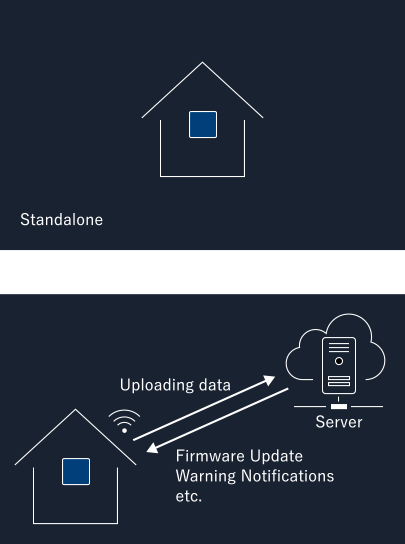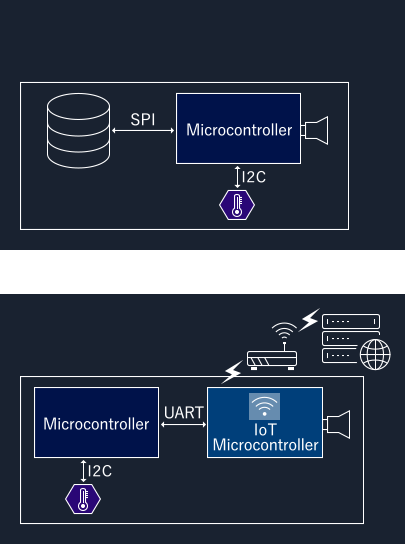IoT Alarm System
By adding internet connectivity capabilities to standalone products, it has become possible to exchange various information.
We achieved shorter delivery times and cost reduction by providing end-to-end system development support, from software development to board development.
We achieved shorter delivery times and cost reduction by providing end-to-end system development support, from software development to board development.
Development Overview
We have transformed our existing standalone product into an IoT-enabled version.
The original product had no networking capability and could only produce voice using built-in voice data.
By incorporating wireless LAN functionality, it became possible to establish a connection with a server. Additionally, the server is designed to provide context-specific voice data, allowing for the output of various voice data. We achieve this voice output through streaming playback.
By providing end-to-end support, from software development to board development, we have achieved shorter delivery times and cost reduction.
The original product had no networking capability and could only produce voice using built-in voice data.
By incorporating wireless LAN functionality, it became possible to establish a connection with a server. Additionally, the server is designed to provide context-specific voice data, allowing for the output of various voice data. We achieve this voice output through streaming playback.
By providing end-to-end support, from software development to board development, we have achieved shorter delivery times and cost reduction.


Customer Challenges and Requirements
Challenges
We had a consultation from a client who develops and sells their standalone products, with the desire to cost-effectively incorporate IoT capabilities into these products, despite lacking expertise in IoT.
Requirements
- Their objective is to enable existing standalone products to connect to the internet wirelessly.
- We plan to provide two connection settings for Wi-Fi routers, including automatic and manual options.
- Data will be stored on a dedicated server (cloud).
- Additionally, we'll implement a mechanism where the dedicated server can notify through voice streaming when it detects specific outputs.
- The system will also allow for software updates via the internet.
Development Content


Microcontroller
- Retrieve sensor output.
- Play audio data from storage.
IoT Microcontroller
We have implemented the following functions:- Upload sensor data to the server.
- Download audio data from the server and play it through streaming.
- Download and update the latest firmware from the server.
1.System Design
End-to-End Support from Software Development to Board Development
We offer a one-stop solution by collaborating with our in-house electrical circuit design and board design team, software development team, and business IT support team, enabling us to address a wide range of fields. From software development to board development, we provided total support for system development.
Selecting Microcontrollers Based on System Features and Specifications
Choosing the right microcontroller involves considering various factors. It's crucial to select a microcontroller that possesses the characteristics to meet the required specifications.
Leveraging our experience in communication device development and embedded development, we have chosen an appropriate microcontroller.
Leveraging our experience in communication device development and embedded development, we have chosen an appropriate microcontroller.
Reducing Development Time
We achieved a reduction in development time by separating the microcontroller responsible for existing functions from the one handling IoT capabilities.
Cost Reduction in Development
We reduced costs by building upon the existing source code and adding only the essential functionalities.
2.Network
We utilized our experience in communication device development to propose features and the use of protocols.
Wi-Fi Router Connectivity Feature
- Automatic Connection: Achieved using WPS (Wi-Fi Protected Setup).
- Manual Connection: The product simulates an access point, allowing users to configure it from their devices.
Utilized Protocols
The IoT protocol uses MQTTS (Message Queuing Telemetry Transport Secure) and HTTPS (Hypertext Transfer Protocol Secure).
- MQTTS (SSL): Used for data storage on the dedicated server. Achieves lightweight and secure communication.
- HTTPS: Used for firmware updates and streaming playback.Provides highly reliable and secure communication.
3.Board
Achieving a compact board size.
- Multi-layer board design for space-saving considerations.
- AC/DC power supply design with noise and safety in mind.
- DC/DC power supply design considering noise and high currents.
- Other factors such as impedance control for antenna patterns.
-
- ADC
- Sensor
- Power management
- Oscillator
- Motor control
- Audio
- Development of a sensor image evaluation system for automotive applications
- Development of a hardware platform for OpenCV implementation in automotive applications.
- Development of industrial camera systems
- CIS digital design
- Digital circuit design for mixed-signal LSI.
- Digital signal processing design
![[Image]SANEI HYTECHS](/en/shared/img/logo_w.png)